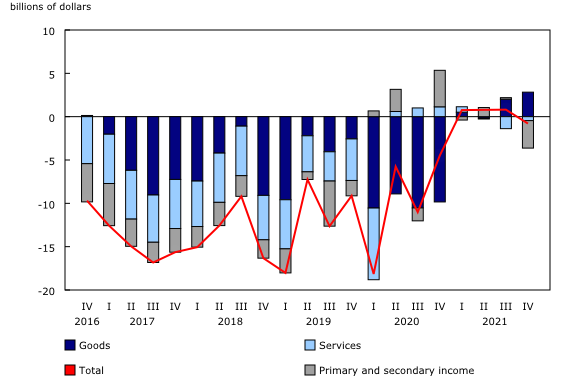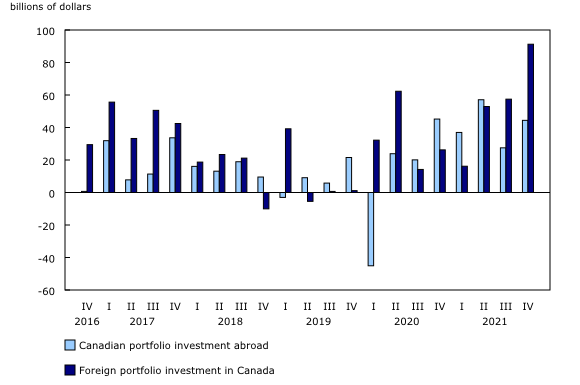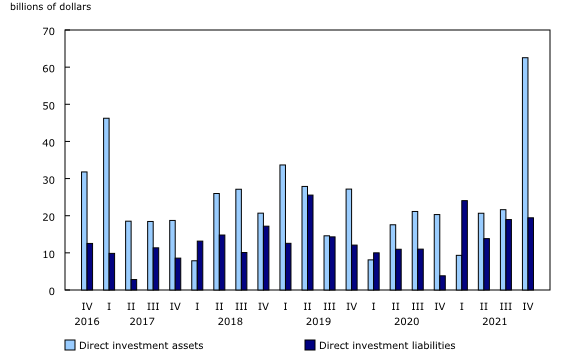OTTAWA
,
February 28, 2022
(press release)
–
Canada's current account balance (on a seasonally adjusted basis) recorded a $0.8 billion deficit in the fourth quarter of 2021 after posting a $0.8 billion surplus in the previous quarter. The slight deficit position mainly reflected a deterioration of the investment income balance which posted its first deficit in over two years. In the financial account (unadjusted for seasonal variation), record foreign investment in Canadian securities was the main contributor to the inflow of funds in the economy. This activity was moderated by strong Canadian acquisitions of foreign securities in the fourth quarter. Direct investment abroad surged in the fourth quarter, on higher mergers and acquisitions activity. Consequently, direct investment abroad exceeded direct investment in Canada by $43.1 billion, the highest value on record. Chart 1: Current account balances Current account Exports of goods were up by $10.2 billion to $170.7 billion in the fourth quarter. The largest contributor was energy products (+$5.1 billion), mostly through higher prices. Other major contributors were motor vehicles and parts (+$2.6 billion) due to higher volumes—and consumer goods (+$1.5 billion) led by pharmaceutical and medical products. Meanwhile, imports of goods rose by $9.3 billion to $167.9 billion. Consumer goods increased by $3.0 billion, largely on higher imports of pharmaceutical and medicinal products. The increase in exports and imports of pharmaceutical and medicinal products reflected large shipments that came into Canada for packaging and labelling and were, for the most part, subsequently exported during the fourth quarter. Motor vehicles and parts were up $2.8 billion on stronger volumes. On a geographical basis, the goods surplus with the United States was up by $2.3 billion in the fourth quarter with exports increasing by more than imports. The deficit with countries other than the United States increased by $1.5 billion. The trade deficit with China rose by $1.5 billion as imports reached a record-high $15.3 billion in the quarter. The trade in services deficit narrowed by $0.9 billion to $0.5 billion in the fourth quarter. The commercial services surplus rose by $1.2 billion to $1.8 billion. Higher exports of both financial services and computer and information services, combined with lower imports of financial services, largely contributed to the increase. Exports and imports of travel services increased by almost similar values in the quarter. The investment income balance posts a deficit Chart 2: Goods balances by geographic area Financial account On the other side of the ledger, Canadian investors acquired $44.4 billion of foreign securities in the fourth quarter, up from $27.5 billion in the previous quarter. Investors purchased an equivalent amount of US shares and foreign debt securities in the fourth quarter. As a result, portfolio investments generated a net inflow of funds in the economy of $46.8 billion in the fourth quarter, the largest since the first quarter of 2020. Chart 3: Foreign portfolio investment Canadian direct investment abroad at a record level Foreign direct investment in Canada amounted to $19.4 billion in the fourth quarter, a level surpassed only twice since 2016. While cross-border mergers and acquisitions were relatively strong at $8.8 billion, earnings reinvested in Canadian affiliates by their foreign parents accounted for most of the activity. Chart 4: Foreign direct investment Year 2021 in review The trade in services deficit narrowed to a low level of $1.3 billion in 2021 as the travel surplus increased. Travel restrictions continued to have a significant impact on travel services during the year, resulting in an unusual surplus position for a second consecutive year. The investment income balance posted a $5.9 billion surplus in 2021, down by $8.6 billion compared with the previous year. Following significant declines in 2020, profits earned in Canada by foreign direct investors rose $26.1 billion, while those earned by Canadians on their direct investments abroad were up by $19.2 billion in 2021. Strong cross-border investment activity in 2021 Foreign investors acquired a record-high $217.8 billion in Canadian securities in 2021. Foreign purchases in the form of debt securities issued by the federal government remained strong, as borrowing needs to support Canadian enterprises and households impacted by the COVID-19 pandemic were still present. On the other side of the ledger, Canadian investors acquired an unprecedented $165.9 billion of foreign securities, significantly higher than the previous record of $84.7 billion observed in 2017. Direct investment activity increased considerably in 2021 following lower investment levels in 2020. Direct investment abroad reached a record-high $114.2 billion, up from $67.1 billion in 2020. More than half of this investment was related to mergers and acquisitions activity and the bulk of the investment was directed to the United States. Meanwhile, direct investment in Canada amounted to $76.3 billion, the highest level since 2007. On a sector basis, foreign direct investment was mainly directed to the manufacturing as well as the energy and mining industry in Canada. Note to readers The current account covers transactions in goods, services, compensation of employees, investment income and secondary income (current transfers). The current account data in this release are seasonally adjusted. For information on seasonal adjustment, see Seasonally adjusted data – Frequently asked questions. The capital account covers capital transfers and transactions in non-produced, non-financial assets. The financial account covers transactions in financial assets and liabilities. In principle, a net lending (+) or net borrowing (-) derived from the sum of the current and capital accounts corresponds to a net lending (+) or net borrowing (-) derived from the financial account. In practice, as data are compiled from multiple sources, this is rarely the case and gives rise to measurement error. The discrepancy (net errors and omissions) is the unobserved net inflow or outflow. Foreign direct investment is presented on an asset-liability principle basis (that is, gross basis) in the financial account. Foreign direct investment can also be presented on a directional principle basis (that is, net basis), as shown in supplementary foreign direct investment tables 36-10-0025-01, 36-10-0026-01, 36-10-0473-01 and 36-10-0656-01. The difference between the two foreign direct investment conceptual presentations resides in the classification of reverse investment such as (1) Canadian affiliates' claims on foreign parents and (2) Canadian parents' liabilities to foreign affiliates. Under the asset-liability presentation, (1) is classified as an asset and included in direct investment assets, also referred to as direct investment abroad in this text, and (2) is classified as a liability and included in direct investment liability, also referred to as direct investment in Canada in this text. For more information on the balance of payments, consult "Chapter 8. International Accounts," in the User Guide: Canadian System of Macroeconomic Accounts, available on our website. The chapter also presents the most recent balance of payments statistics. Real-time table Next release Products The product Canada and the World Statistics Hub (Catalogue number13-609-X) is available online. This product illustrates the nature and extent of Canada's economic and financial relationship with the world using interactive graphs and tables. This product provides easy access to information on trade, investment, employment and travel between Canada and a number of countries, including the United States, the United Kingdom, Mexico, China and Japan. The Economic accounts statistics and International trade statistics portals are available from the Subjects module of the Statistics Canada website. The product Methodology for Exports of Energy Products within the International Merchandise Trade Program, which is part of Latest Developments in the Canadian Economic Accounts (Catalogue number13-605-X), is available. The Methodological Guide: Canadian System of Macroeconomic Accounts (Catalogue number13-607-X) is available. The User Guide: Canadian System of Macroeconomic Accounts (Catalogue number13-606-G) is also available. Contact information Industry Intelligence Editor's Note: This press release omits select charts and/or marketing language for editorial clarity. Click here to view the full report.
Trade in goods and services balance remains in a surplus position
The trade in goods and services balance posted a $2.4 billion surplus in the fourth quarter, a third quarterly surplus recorded in 2021. Prior to 2021, the last surplus recorded was in 2008.
The investment income balance went from a $1.4 billion surplus in the third quarter to a $1.1 billion deficit in the fourth quarter, mainly due to foreign direct investment. Profits earned by foreign direct investors on their assets in Canada were up $1.7 billion, while those earned by Canadian direct investors on their assets abroad declined $0.7 billion.
Foreign investment in Canadian securities hits a record high
Foreign investment in Canadian securities reached an unprecedented $91.2 billion in the fourth quarter, up from $57.5 billion in the third quarter. Foreign investors acquired $73.7 billion of Canadian debt securities, mainly bonds. Issuances of new Canadian shares to foreign portfolio investors resulting from cross-border mergers and acquisitions also contributed to the investment activity.
Direct investment abroad reached a record-high $62.5 billion in the fourth quarter, a level higher than the previous three quarters combined. Cross-border mergers and acquisitions ($45.9 billion) largely contributed to the investment activity. Most of the Canadian direct investment abroad was in the trade and transportation sector, and directed to the United States.
First current account surplus since 2008
For the year 2021, the current account balance recorded a surplus of $1.6 billion, the first surplus since 2008. The trade in goods balance went from a $39.8 billion deficit in 2020 to a $5.2 billion surplus in 2021. Total exports rose by $113.6 billion, led by higher exports of energy products on the strength of prices. Meanwhile, imports increased by $68.6 billion, with gains widespread across product sections. For more information about the annual trade in goods, consult "Canadian international merchandise trade, December 2021."
In the financial account, portfolio investment generated a net inflow of funds in the economy of $51.9 billion. Meanwhile, direct investment activity generated a net outflow of funds totalling $37.9 billion.
Definitions
The balance of international payments covers all economic transactions between Canadian residents and non-residents in three accounts: the current account, the capital account and the financial account.
Real-time table 36-10-0042-01 will be updated on March 7, 2022. For more information, see Real-time tables.
Balance of international payments data for the first quarter of 2022 will be released on May 30, 2022.
The product Canada's international trade and investment country fact sheet (Catalogue number71-607-X) is available online. This product provides easy and centralized access to Canada's international trade and investment statistics, on a country by country basis. It contains annual information for nearly 250 trading partners in summary form, including charts, tables and a short analysis that can also be exported in PDF format.
For more information, or to enquire about the concepts, methods or data quality of this release, contact us (toll-free 1-800-263-1136; 514-283-8300; infostats@statcan.gc.ca) or Media Relations (statcan.mediahotline-ligneinfomedias.statcan@statcan.gc.ca).
* All content is copyrighted by Industry Intelligence, or the original respective author or source. You may not recirculate, redistrubte or publish the analysis and presentation included in the service without Industry Intelligence's prior written consent. Please review our terms of use.




